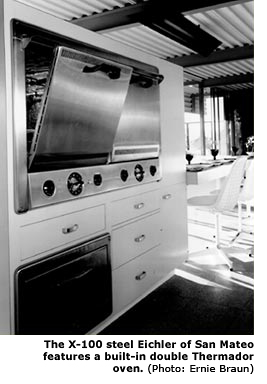Thermador Ovens and Cooktops - Page 2
"Everybody coming back from the war was used to looking at dials and gauges, whether on an instrument panel in a plane or the controls of a radio," said 'Ric Coggins, southwest regional manager of operations for Freed Appliance Distributors, Thermador's largest national distributor. Coggins also prides himself as being an avid historian on the Thermador company.
Thermador streamlined its design early on, starting in 1947, but by the middle and late 1950s minimalism was the rage. Eichler homes themselves represent a major step towards a minimalist aesthetic with their use of straight lines and built-in fixtures and appliances. Part of this design scheme was the color, or lack thereof, with which Thermadors were finished.
"I remember he liked the color very much," said former Eichler construction superintendent Bill Wills on why Joe Eichler had selected Thermador. "The thing with Eichler was that if he really liked something, he would never change it." All Thermadors at that time came in the same stainless, medium-brush finish that dominates residential and commercial kitchens today.

In the early '60s Thermador experimented with tinting their trademark stainless steel, but their next truly innovative move with color was the introduction of black glass in the 1965 models. After a hundred years of white appliances, and a brief dip into tones like mint or beige in the '40s, Americans finally had color choices that would remain both bold and classic.
The art deco movement that swept the design world between the two world wars set designers up for minimalism, but until World War II, a heavy, solid feel remained popular. Though the technology existed to mount an oven in the wall, trends ran against that in favor of a detached, heavy-looking contraption on legs. During the war the airplane emerged as the coolest thing in the world, and designers soon picked up on its streamlined style.
The difference between the wall oven and the previously developed floor models is primarily one of height. No significant technological advances had to come about to allow Thermador to install an oven at arm level. They were just the first ones to do it. The ovens and ranges, while revolutionary in their design and installation, remained pretty much standard in their engineering.
What they revolutionized was not what families cook, nor how the food gets hot, but rather how they live while cooking. For homes that were marketed as the basis of a life-style, the split oven and range made a smart choice. For Eichler, they dovetailed well with "bringing the outside in and the inside out," as Catherine Munson points out.
The heavily styled appliances supported the Eichler lifestyle because of their obscuring of boundaries. With its simple innovations-in-design, Thermador, much like Eichler, helped begin a trend toward utilizing the living space for actually living instead of just for sleeping and storing things.
"Previous to Eichler homes, kitchens were their own distinct space," said Coggins. "Typically, in a wealthy or more affluent house, the kitchen was a utilitarian room, separate from the rest of the house, that only the domestic staff entered. What a novel concept to pull the kitchen into the house and make cooking part of entertaining." Even small, suburban homes of the time had isolated kitchens, walled off from the formal dining and sitting rooms and accessed by swinging doors.
The design and installation of the Thermador appliances blurred the line between working in the kitchen and living there as a room in the house. The separate electric cooktop range, a Thermador invention first introduced in 1947, allowed for more than one person to participate in the cooking. The elevated oven made baking less labor intensive than with floor models. The modern design made the appliances part of an attractive surrounding rather than a utilitarian kitchen.
With the oven removed from the cooktop, it was possible to install this formerly cumbersome appliance anywhere in the kitchen, paving the way for the swing-out table, a feature common to many Eichlers, which integrated the eating table and stove. This island fixture was typically placed at the entry point of the kitchen, dividing the room from the rest of the house. But since it did not stretch from wall to wall, or up to the ceiling, it left the space open and continuous.

The cooktop could also be installed in a serving counter or pony wall, allowing the mother to cook while watching and playing with her children, or the chef to face the guests and be involved in the party. These connected kitchens usually blended with a dining/family room to create a large, comfortable space focused on eating, drinking, and socializing.
Since most household chores tend to take place in or at least in association with the kitchen, Eichler's concept of blending leisure and work comes through strongly there. While entertaining, hosts could spend considerable time in the kitchen without missing a step. The Eichler model brought the party to the host.




